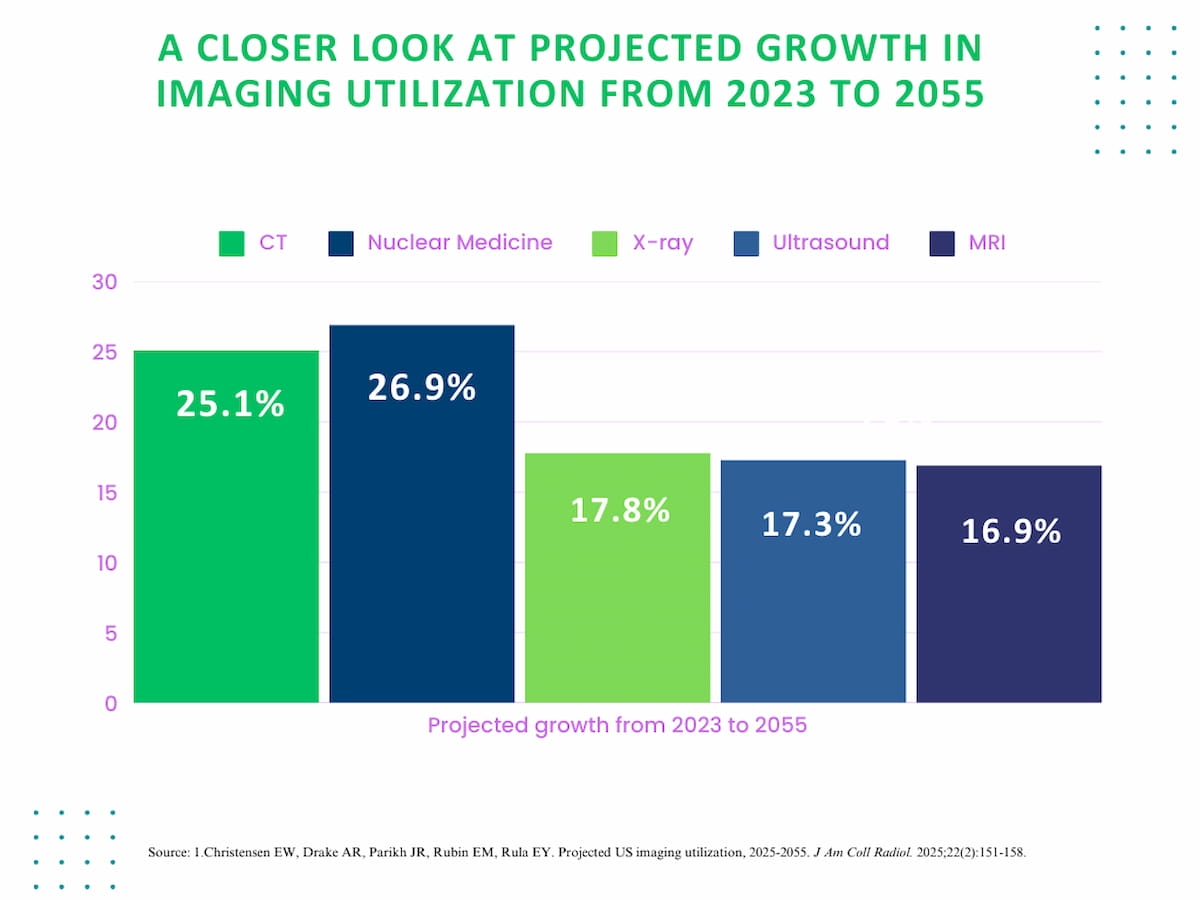Forecasting Supply and Demand in Radiology in 2055
Reviewing current and emerging trends in imaging utilization and the impact of attrition rates and radiology residency positions on the field, researchers explore the future of radiology with two new provocative studies.
Researchers estimate a nearly 27 percent increase in imaging utilization over the next 30 years. However, if current attrition rates in the radiology field persist without growth in radiology residency positions, the same researchers suggest the radiology workforce will be “substantially smaller” than it is now.
In two new studies, recently published in the Journal of the American College of Radiology, researchers offer projections on future imaging utilization and the state of the radiology workforce based on different scenarios of residency position growth or lack thereof, and attrition rates.
Here are seven key takeaways from the studies.
- Assuming no growth in radiology residency positions after 2024, the study authors projected a 25.7 percent increase in the number of radiologists providing care for Medicare beneficiaries in 2055. However, if there is radiology residency growth at the rate of historical trends, the researchers estimated a 40.3 percent growth of the radiology workforce serving Medicare patients from 2023 to 2055.1
- The researchers projected a 25.1 percent growth in computed tomography (CT) utilization over the next 30 years, noting that 17.1 of the increase is attributable to population growth estimates and 6.2 percent derived from expected aging of the population.2
Incorporating imaging utilization rates from 2022 with projected trends in the United States population, the researchers forecasted a 25.1 percent increase in computed tomography (CT) scans, a 26.9 percent increase in nuclear medicine utilization by 2055 along with a 17.8 percent growth in X-rays, a 17.3 percent growth in ultrasound use and a 16.9 percent increase in magnetic resonance imaging (MRI).

3. Noting studies that revealed higher number of health-care providers seeking to reduce work hours or leave their practice altogether, and a 63 percent burnout rate in the wake of the COVID-19 pandemic, the researchers pointed out a 3 percent post-COVID-19 attrition rate for radiologists compared to 1.9 percent prior to the pandemic.1
4. Incorporating imaging utilization rates from 2022 with projected trends in the United States population, the researchers forecasted a 26.9 percent increase in nuclear medicine utilization by 2055 along with a 17.8 percent growth in X-rays, a 17.3 percent growth in ultrasound use and a 16.9 percent increase in magnetic resonance imaging (MRI).2
5. For the first two years of a five-year process with the Centers for Medicare and Medicaid Services (CMS) adding 200 new residency positions a year in health care, the study authors noted that radiology accounted for a total of 16.9 new residency positions in the last two years.1
6. While noting that imaging utilization per person is “substantially higher” for Medicare fee for service, the researchers pointed out current trends with beneficiaries preferring Medicare advantage. Between 2023 and 2055, the study authors forecasted a 70.7 percent increase in patients using Medicare Advantage in contrast to an 8.9 percent increase in Medicare fee for service plans.2
7. If attrition in radiology persists at post-COVID-19 levels, the researchers estimated a 20.9 percent growth in the radiology workforce by 2055. If attrition decreases back to pre-COVID-19 rates, the study authors forecast a 29.2 percent increase in the radiology workforce.1
References
1. Christensen EW, Parikh JR, Drake AR, Rubin EM, Rula EY. Projected US radiologist supply, 2025 to 2055. J Am Coll Radiol. 2025;22(2):161-169.
2. Christensen EW, Drake AR, Parikh JR, Rubin EM, Rula EY. Projected US imaging utilization, 2025-2055. J Am Coll Radiol. 2025;22(2):151-158.
Can CT-Based AI Radiomics Enhance Prediction of Recurrence-Free Survival for Non-Metastatic ccRCC?
April 14th 2025In comparison to a model based on clinicopathological risk factors, a CT radiomics-based machine learning model offered greater than a 10 percent higher AUC for predicting five-year recurrence-free survival in patients with non-metastatic clear cell renal cell carcinoma (ccRCC).
The Reading Room Podcast: Current Perspectives on the Updated Appropriate Use Criteria for Brain PET
March 18th 2025In a new podcast, Satoshi Minoshima, M.D., Ph.D., and James Williams, Ph.D., share their insights on the recently updated appropriate use criteria for amyloid PET and tau PET in patients with mild cognitive impairment.
Could Lymph Node Distribution Patterns on CT Improve Staging for Colon Cancer?
April 11th 2025For patients with microsatellite instability-high colon cancer, distribution-based clinical lymph node staging (dCN) with computed tomography (CT) offered nearly double the accuracy rate of clinical lymph node staging in a recent study.
The Reading Room Podcast: Emerging Trends in the Radiology Workforce
February 11th 2022Richard Duszak, MD, and Mina Makary, MD, discuss a number of issues, ranging from demographic trends and NPRPs to physician burnout and medical student recruitment, that figure to impact the radiology workforce now and in the near future.
Could Ultrafast MRI Enhance Detection of Malignant Foci for Breast Cancer?
April 10th 2025In a new study involving over 120 women, nearly two-thirds of whom had a family history of breast cancer, ultrafast MRI findings revealed a 5 percent increase in malignancy risk for each second increase in the difference between lesion and background parenchymal enhancement (BPE) time to enhancement (TTE).